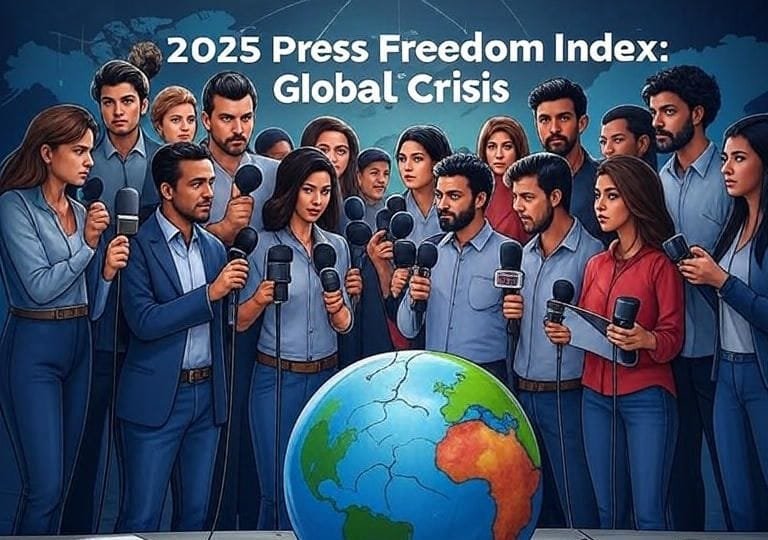New Delhi, August 31, 2025, 09:43 PM IST – The 2025 World Press Freedom Index, released by Reporters Without Borders (RSF) on May 2, 2025, offers a critical assessment of media freedom across 180 countries and territories. This annual ranking, now in its 23rd year, evaluates the ability of journalists to work independently, free from political interference, economic pressures, and physical threats. As the world grapples with rising authoritarianism and economic instability, the 2025 edition paints a concerning picture, marking the first time global press freedom has been classified as a “difficult situation.” Here’s an in-depth look at the rankings, regional trends, and the factors shaping this year’s outcomes.
Top and Bottom Rankings
Norway continues to lead the index with a score of 92.31 out of 100, reflecting its robust legal protections, diverse media landscape, and zero tolerance for press suppression. Estonia (89.46) and the Netherlands (88.64) follow, benefiting from strong democratic institutions and minimal state interference. These Scandinavian and European nations consistently dominate the top tier, showcasing a commitment to media pluralism and journalist safety.
At the opposite end, Eritrea ranks last at 180, where all independent media have been banned since 2001 under a repressive dictatorship. North Korea (179), China (178), and Syria (177) also languish near the bottom, characterized by state-controlled narratives, censorship, and rampant violence against journalists. The bottom 10 countries highlight a stark contrast, where press freedom is virtually nonexistent, and dissent is met with severe repercussions.
Regional Insights
The 2025 index reveals stark regional disparities. Europe remains the safest region for journalists, with the European Union-Balkans zone leading globally. However, even here, countries like Germany (11th) have slipped due to rising far-right threats, dropping out of the top 10. The Eastern Europe-Central Asia (EEAC) region saw the steepest decline, with nations like Kazakhstan (141st) slipping into the “very serious” category due to tightened state control.
In the Asia-Pacific, 20 of 32 countries, including India (151st), experienced a drop in economic scores, driven by media ownership concentration and authoritarian influence. The Middle East-North Africa (MENA) region remains the most dangerous, with Palestine (163rd) facing catastrophic conditions due to ongoing conflict, where over 100 journalists have been killed since October 2023. Economic fragility, exacerbated by advertising monopolies and funding cuts, is a recurring theme across regions, lowering the global economic indicator to its lowest point in the index’s history.
India’s Position and Challenges
India’s ranking improved marginally from 159th in 2024 to 151st in 2025, with a score of 32.96. However, this slight uptick masks persistent issues, as the country remains in the “very serious” category. The RSF report cites violence against journalists, concentrated media ownership tied to political and corporate interests, and legal pressures as key concerns. Compared to neighbors like Nepal (90th) and the Maldives (104th), India lags, reflecting a challenging environment for press autonomy.
The improvement is attributed to reduced physical attacks on journalists, but economic pressures and harassment of those critical of the government continue to erode media independence. The global classification of press freedom as “difficult” resonates in India, where over half the population now lives in areas with severe media restrictions, amplifying the need for structural reforms.
Global Trends and Economic Pressures
The 2025 index underscores a historic low, with the global average score dipping below 55, driven by an unprecedented decline in the economic indicator. In 160 of 180 countries, media outlets struggle to achieve financial stability, and nearly a third report closures due to economic hardship. This trend is fueled by the dominance of tech giants like Google and Meta, which siphon advertising revenue, and the concentration of media ownership in 46 countries, where editorial interference is common.
Violence remains a visible threat, with the Committee to Protect Journalists (CPJ) reporting 103 journalist deaths in 2024 and 15 more by April 2025. Mexico (124th) and Palestine stand out as deadly zones, while legal restrictions, such as defamation laws in Bangladesh, further stifle free expression. The index warns that these combined pressures are undermining the public’s right to reliable information, a cornerstone of democratic societies.
Implications and Future Outlook
The declining state of press freedom signals a broader erosion of democratic values, with over 4.25 billion people—more than half the world’s population—living in countries with “very serious” conditions. RSF calls for urgent government action to protect journalists and diversify media funding, emphasizing the role of international cooperation in upholding media rights.
For India, the modest ranking improvement offers little comfort, as systemic challenges persist. The government’s focus on regulating digital platforms and addressing economic pressures will be critical to reversing this trend. Globally, the shift toward economic resilience and legal safeguards could determine whether the 2026 index reflects recovery or further decline.
As the world marks Press Freedom Day on May 3, 2025, the 2025 World Press Freedom Index serves as a wake-up call, urging stakeholders to safeguard a free press amid growing threats. The data, gathered from over 5,000 respondents including journalists and policymakers, underscores the urgent need for action to preserve this fundamental right.
Sources: Insights derived from RSF’s official 2025 report.



Average Rating